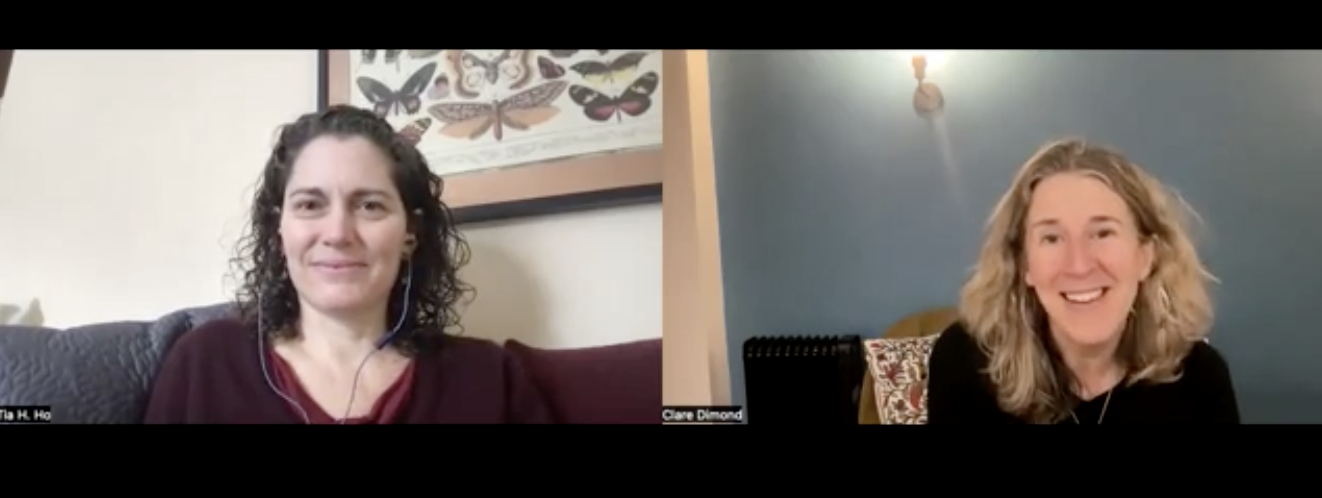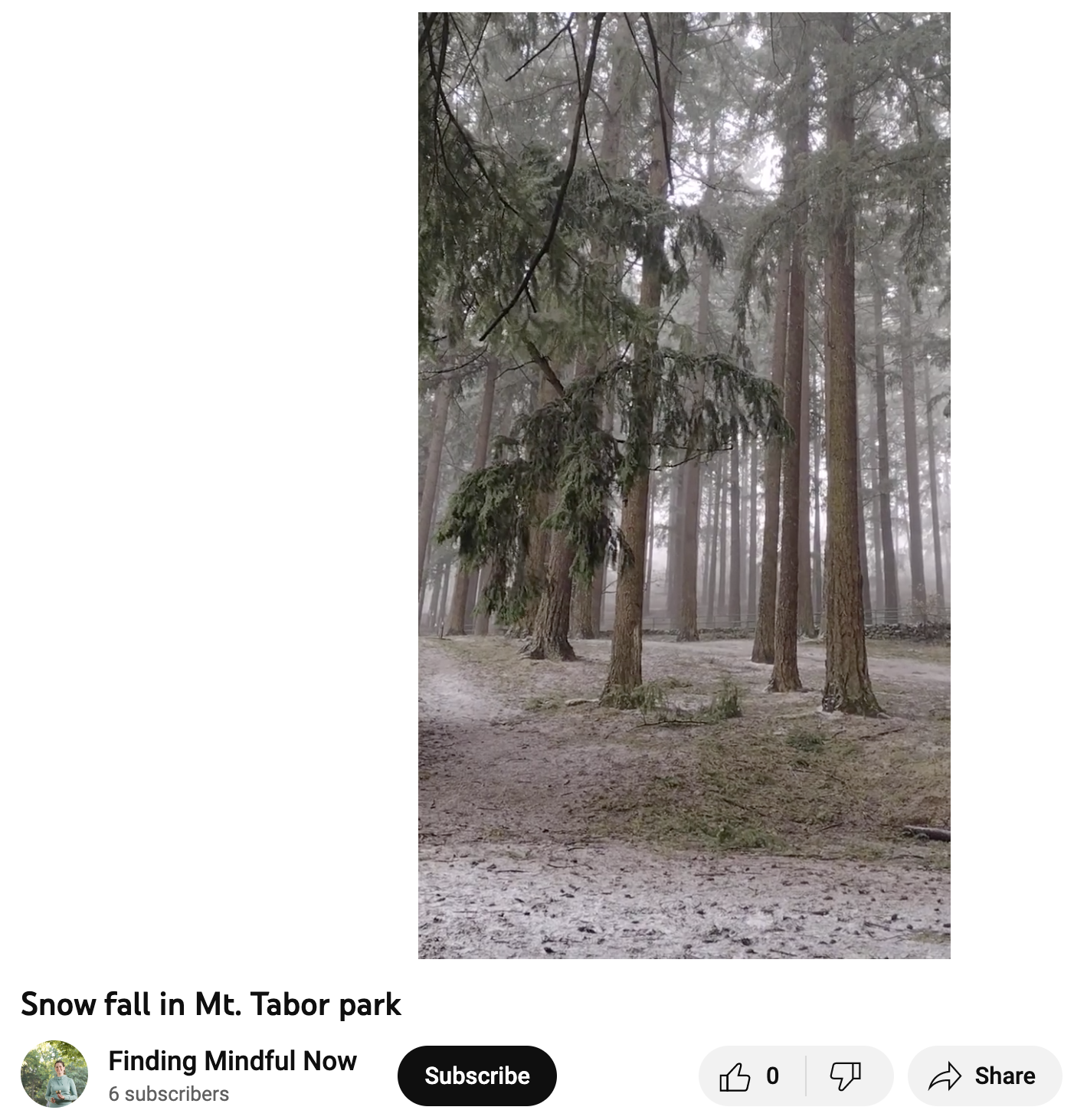Moment of Mind February 2023
If you're in the U.S. you may be celebrating Black history month. My favorite daily readings curated by Black people making history now is from Antiracism Daily [https://eagywq.clicks.mlsend.com/te/cl/eyJ2Ijoie1wiYVwiOjI3MTkzOCxcImxcIjo4MTI5OTY2Nzc0ODM5MDE1OSxcInJcIjo4MTI5OTY3NzY2NzkxOTQ5OX0iLCJzIjo

Video in what is now called Mt. Tabor park on the eve of the February 2023 snow storm in what's now called Portland, Oregon. On original land of the Chinook, Confederated Tribes of Grand Ronde, Confederated Tribes of Siletz and many more indigenous communities.
Moment of Mind
I hope this email finds you as safe and supported as possible this month.
A body-based support I invite you to explore is the slowing down of a nervous movement. I invite you to notice any movement your body does when there's anxiety or nervousness arising. Then notice what happens if you slow it down...what feels okay about that motion, what feels uncomfortable about it, and anything in between?
The body is in continual motion at the most tiniest of levels. The cells are dividing, the electrons are beating the heart, neurons are sending signals, emotions are energy moving through, and so on.
When our nervous system encounters something that the mind judges is too much, too fast, or too big this registers as a potential threat to the body. Sometimes the threat only affects our idea of us (the self concept), and the brain will act as though the body is threatened even when we are physically safe. As I mentioned last month in the Instagram series, the brain then activates some mixture of the sympathetic (fight, flight) and parasympathetic (freeze, fawn) nervous system states to respond to that perceived threat. This is where we get various coping mechanisms in play. This is the genius of our system doing its best based on the predictions it's generating from learned/absorbed past experience, current inputs, and where attention is resting.
You can choose any movement that happens when you feel a lot of anxiety. Maybe it's noticing how narrow the breathing gets, or a holding of the jaw, maybe tapping of a foot, or pacing around the house. You might have a variety (we all do), and that's great.
I have been a hair twister since I was a child.
When a lot of anxiety is running in the system, twisting or twirling hair around my fingers turns into tight tugging and even pulling hair out. I often give myself a callous around the base of my middle finger from the repeated hair friction. My hair dresser knows that there will generally be a section of hair where the ends are broken. While it's a soothing habit the inner child adopted decades ago, I'm not convinced it's supporting the nervous system release as much as it could. These movements are an attempt by the body to discharge, or release the nervous tension that's emerging. Often this comes from some belief that the self concept is threatened ("what if I fail? what if I can't do it? what if I'm wrong? what if they hurt me? what if they don't like me?" etc.) running. Notice these are all thought patterns centered around an idea of a separate me about some future possibility that isn't happening in this moment.
In cultivating bodily awareness we're directing the attention of awareness into the patterns of movement and sensation our bodies have developed and gathered over time. That noticing what's happening from awareness combined with open curiosity gives the body an opening to shift patterns. It's also getting very present with what's happening in this moment, which brings the brain back to registering relative safety, shifting away from registering perceived threat from its own thought creations about the past or future.
Note that there's no conscious controller that created these habits to begin with.
Our nervous system is running unconsciously by the core truth of us - living intelligence in form - to keep the whole human brain body system safe. That might sound strange. How could we be living intelligence? Well, did the conscious you choose your current heart beat? How about what the hormones are doing? Are you consciously making cells divide? How about blinking the eyes? Making saliva? Moderating bodily temperature? What's doing that? Does it seem like some form of intelligence? Biology is the study of life. So if it's biology...is it maybe life force? If so, how could you be separate from it?
What about the thoughts that show up in the conscious mind - can you control those? Give it a try for 60 seconds and see if you can make only one topic of thoughts, say about your favorite animal go on in the mind. This is one of my favorite thought experiments. Even if my mind just repeats "fuzzy panda" for awhile it also thinks of looking at the clock, noticing sounds, etc. While two decades of meditation has brought mental states with *less* mind chatter, there's still no choosing what thoughts pop in during meditation.
If we could control our thoughts, we would.
There's no controlling what thoughts show up in the conscious mind - they are part of the unconscious predictive system designed to keep us alive as long as possible. We get very confused when we believe those thoughts to be us rather than informative experiences we get to have.
We take much of the biology of our self organizing brain body system for granted until it does something we've been taught to judge and dislike.
Playing with the patterns that developed is intelligence in action.
Here's what it's like when I apply the invitation to my own pattern.
- The hand is up and twisting hair and it's noticed: "oh, hey, my hand is twisting my hair furiously now".
- There's the intention of getting really curious with the motion.
- And in that inquiry of "what's going on with that?"
- The twisting and twirling slows way down.
- Now there's feeling into the sensations of the hair wound around the finger, how the hair feels, how the hand feels, and so on.
- I notice that the hair is soft if I don't move as fast.
- That the impulse to twist it releases the more it's held and witnessed. Instead, the hand gently feels into the texture of the hair, looks at a curl, and then drops it.
When we slow a nervous movement down like this we get present with it. The core awareness that you are witnesses it. And this softens some of what's happening, instead of fighting it. The nervous system shifts as the relative safety of the present moment is tracked.
I'd love to hear what you notice,
much love,
Tia

My Coach Interviews Me
I recently had the honor of being interviewed by my life coach Clare Dimond in her podcast. She receives a number of inquiries regularly about how bodywork is connected to healing and wanted to hear more about its role in my process. Fresh out of Embody Lab's Integrated Somatic Trauma Therapy certification last month I've been continuing to explore using mindfulness of bodily sensations as emotional capacity resources. You can hear more in our chat by clicking on the image or the header.
Image of Clare and Tia screenshot from interview.
Love for Your Inner Science Activist Nerd
Here are two studies that caught my attention this month.
Revisiting Measured Breathing for Anxiety
Researchers over at the Huberman Lab (the second link takes you to a podcast going over the study) tested four different styles of measured breathing out to learn what impact each had on stress physiology (respiratory rate, heart rate and heart rate variability).
They tested 1) cyclic sighing where you inhale all you can in, expanding your diaphragm/belly and then slowly exhale while making an auditory sigh sound, 2) box breathing where you inhale, hold and exhale in an equal duration pattern, 3) cycles of intentional hyperventilation with longer inhalations and shorter exhalations compared to 4) mindfulness meditation over 1 month.
The evidence indicates that spending five minutes a day with cyclic sighing resulted in improved mood, lower respiratory rate, and reduced anxiety better than a mindfulness meditation focused on the breath, or the three other breathing formats.
What's "cyclic sighing"? It's inhaling fully, letting your belly pooch out, sucking one last bit of air in after you're already full, then slowly exhaling while you make an 'ahhh' or 'oooo' or 'zeeee' sound ...a soft sigh. The slow exhale and the auditory sigh both engage the vagus nerve, the most valuable player in the parasympathetic nervous system (PNS) that's responsible for your "gut sense" or the "inside seeing" of interoception of the organs. The PNS sends signals of our bodily "mood" or physiological affect to the brain. The brain combines this with external sensory inputs and past experiences to create emotions like anxiety. It's possible this pattern sends signals of relative safety to the brain and supports a slight increase in positive affect and a decrease in negative affect.
I've starting doing this in between errands (when no one can hear the sounds) and just before bed. I invite you to try it out and see what you notice about its use as a nervous system support for your system.
Source: Balban et al (2023) Brief structured respiration practices enhance mood and reduce physiological arousal, Cell Reports Medicine, 4(1), 100895.
Moving the Body and Depression
While it's likely not a surprise moving the body is important for health, a group of researchers found evidence of a dose response relationship between replacing sitting with being physically active and decreasing the odds of depression. While there are many studies that indicate the relationship between being more active and feeling less blue, it's been unclear what direction that relationship goes. Is it that people who feel less depressed move more or when people move more they feel less depressed, or both?
Choi and colleagues found that in relation to genetics, it's the moving more that results in less risk of depression direction. They estimate that if a sedentary person (someone who sits a lot) replaces one hour of not moving with an hour of moderate activity or 15 minutes of intense activity every day, the risk of depression lowers by about 25 percent (that's a big number in research studies). They used physical measurements of activity beyond self-report as people's minds may not always align with their actual activity level because mood states and cognitive biases can affect their judgments.
Apparently when our bodies intentionally engage in the physical stress of exercise it supports the mental state of being able to handle emotional stress better. To put it another way, physical challenge helps us respond to emotional challenge. This may be linked to the fact that contracting muscles releases a cascade of proteins, called myokines, that affect multiple systems in the body - so much so that skeletal muscles are now considered another endocrine organ (Severinson et al., 2020).
As another set of researchers put it, move more while sitting or move more and sit less is the bottom line.
Sources:
Choi et al (2019). Assessment of bidirectional relationships between physical activity and depression among adults: A 2-Sample Mendelian randomization study. JAMA Psychiatry, 76(4): 399-408
Severinson et al (2020). Muscle–Organ Crosstalk: The Emerging Roles of Myokines, Endocrine Reviews, Volume 41, Issue 4, August 2020, Pages 594–609.
Get Your Park Groove On
Instead of featuring a specific park this month I thought I'd share about a handy tool I just learned about called the "Natural Atlas." It has a free service you can link to an email account and track trips you take using topographical maps. It lets you save topo maps, record trips and make notes at the free service level.
I learned about this the other day when visiting a location I don't know much about and trying to determine where a national park boundary ended and a neighborhood began. The browser I was using brought forward this service and I gave it a try. I'm not an affiliate, and I could see how it could be helpful in a number of situations. It also looks like they're hiring a writer if you're interested or know someone who is. Thought it worth sharing!
Upcoming Events & New Offers

Metamorphosis Membership Starts Soon!
I want to be part of many communities of folks who are intentional in how they learn, share, and grow as they support each other. I'm creating one focused on the perimenopause to post menopause transition.
What if we could be supported together?
What if we could be ushered in and welcomed to this next phase?
What if we could hear people's experiences without anyone trying to fix or tell us what to do?
What if we could be witnessed and honored as it's / we're unfolding?
What if we could embrace our middle ages for what they call us forward into?
Let's explore these questions and others together in a supportive community. Click here to find out how to join me.
Image of blue butterflies on pink brick by drz on unsplash.
| Copyright © 2019-2023, Finding Mindful Now LLC, All rights reserved. www.findingmindfunow.com, originally published on MailerLite with information on current offerings. Some images or content lightly revised since initial publishing. |

